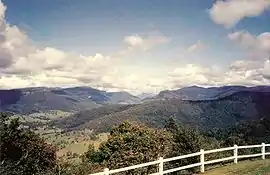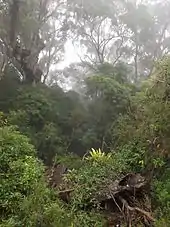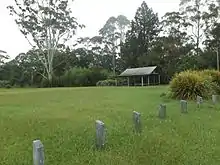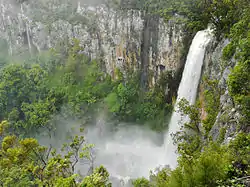Springbrook, Queensland
Springbrook is a mountain and plateau in the Gold Coast hinterland of South East Queensland, Australia.[3] It is also the name of the associated rural town and locality within the City of Gold Coast.[4][5] In the 2016 census the locality of Springbrook had a population of 659 people.[1]
| Springbrook Gold Coast, Queensland | |||||||||||||||
|---|---|---|---|---|---|---|---|---|---|---|---|---|---|---|---|
 Springbrook Plateau (left of image) | |||||||||||||||
 Springbrook | |||||||||||||||
| Coordinates | 28.1838°S 153.2588°E | ||||||||||||||
| Population | 659 (2016 census locality)[1] | ||||||||||||||
| • Density | 12.505/km2 (32.39/sq mi) | ||||||||||||||
| Established | 1906[2] | ||||||||||||||
| Postcode(s) | 4213 | ||||||||||||||
| Area | 52.7 km2 (20.3 sq mi) | ||||||||||||||
| Time zone | AEST (UTC+10:00) | ||||||||||||||
| Location | 42 km (26 mi) from Southport | ||||||||||||||
| LGA(s) | City of Gold Coast | ||||||||||||||
| State electorate(s) | Mudgeeraba | ||||||||||||||
| Federal Division(s) | McPherson | ||||||||||||||
| |||||||||||||||
The locality borders New South Wales.[6]
Geography
The highest point, known as Mt Mumjin or Springbrook Mountain is 1,020 metres (3,350 ft) high at Best of All Lookout carpark according to the latest LIDAR survey by Gold Coast City. The plateau is covered in subtropical rainforest and crossed by many small creeks. The area has excellent views to the Gold Coast and is known for its cliffs, waterfalls and forest walks, most of which are protected in the Springbrook National Park.
Road access to this eastern Scenic Rim mountain is via Mudgeeraba along the Springbrook Road and from Numinbah Valley via Pine Creek Road. To the south of Springbrook is the Tweed Range, west is the Numinbah Valley and the Lamington Plateau. Both the Nimmel Range and Tamborine Mountain are to the north, as is Hinze Dam while the peak of Mount Nimmel is at the north eastern tip. The plateau is part of a biodiversity hot spot. It is part of the Scenic Rim Important Birdlife Area.[7] Pademelons are commonly seen by visitors.
Springbrook Plateau is the remains of the Tweed Volcano—now known as Mount Warning and the Tweed Valley.[8] The plateau is an undulating elevated patch that extends north from the southern, forested heights, close to Mount Cougal, just to the east. These subtropical rainforests are part of the Gondwana Rainforests of Australia and contain the rare Antarctic beech trees.[8] Springbrook plateau has been described as "the Switzerland of Queensland" and a unique wonder.[9] Springbrook was widely considered to be part of the McPherson Range.[9] As the area's geology was understood it has now come to be typically described as a distinct plateau landform.
Notable lookouts on the plateau include Best of All Lookout, overlooking the Tweed Valley directly south of Springbrook, as well as Canyon, Goomoolahra and Purlingbrook lookouts.[10] Springbrook features the Purlingbrook Falls, which is a major tourist attraction as well as Goomoolahra Falls.

The plateau is highly visible on the western horizon from the Gold Coast coastal strip. Springbrook Plateau is in the water catchment area for Tallebudgera Creek and the larger Nerang River dammed by the Hinze Dam, a significant part of the region's water supply infrastructure. Little Nerang Creek flows into Little Nerang Dam in the north of the locality. The Natural Bridge is a rock arch and waterfall on the western slopes of the plateau. A triangulation station is located close to Mount Thillinmam at Bilbrough Lookout. Mobile reception is generally poor at Springbrook.[11]
Preservation
Beginning in 2005 the Beattie Government and Bligh Government spent $40.15 million purchasing 45 properties covering 705 hectares in Springbrook. The aim is to restore critical habitat to world heritage status and eventually expand the Springbrook National Park. The recovery process is conducted by the Australian Rainforest Conservation Society and led by Aila Keto. The land purchases have been criticised because of a lack of accountability, for pushing up land values and negatively affecting tourism by reducing the number of accommodation places, restaurants and cafes.[12]


Springbrook was the site for a trial that involved 200 distributed, wireless sensors that can monitor natural conditions such as humidity, temperature, light, rainfall, fog, water quality and sound.[13] The cutting edge technology was developed by the CSIRO to assist research into the restoration of natural vegetation.
Bush camping is not permitted in the national park.[14] There is one camping area in Carricks Road.[14] Springbrook is the eastern end of the Gold Coast Hinterland Great Walk. This mountain hike links to O'Reilly's Rainforest Retreat via Binna Burra.[15]
Climate
Due to its close proximity to the coast, the high elevations and subtropical latitude, Springbrook has a wet climate with mild temperatures. Rainfall at the now closed Upper Springbrook BOM rainfall station averaged 3109 mm annually over 90 years. Springbrook is the only place in subtropical Australia to exceed 3000 mm average rainfall making it probably the wettest place between Townsville and Tasmania.
Exceptionally rainy periods have been recorded in some wet years including; 900 mm of rainfall recorded in a 24-hour period before an unnamed cyclone crossed the coast at Coolangatta on 20 February 1954.[16] During a remarkable rainy period, Springbrook received 1,631 millimetres (64.2 in) in the month of June 1967.[17] In January 2013, 1,453 millimetres (57.2 in) of rain fell over a period of just 4 days, due to the remnants of Tropical Cyclone Oswald. In March 2017, 1,407 millimetres (55.4 in) of rain fell[18] in part due to Cyclone Debbie, 789 millimetres (31.1 in) of which was recorded at Upper Springbrook on the 31st of March 2017, causing enough damage to cut off the two access routes into Springbrook and leaving many residents without electricity.[19]
Flora and Fauna
Springbrook has a rich biodiversity that is among the highest diversity of flora, fauna and fungi in Subtropical Australia. Habitat types include Montane Sclerophyll Forests dominated by temperate eucalyptus trees such as New England Blackbutt (Eucalyptus campanulata) and Blue Mountain Ash (Eucalyptus oreades) both of which are near their Northern limit of distribution. Rocky outcrops and cliffs support Montane Heath shrublands dominated by Tea Trees Leptospermum variable and L. petersonii, Mountain Bottlebrush Melaleuca montana and Cliff Bottlebrush M. comboynensis. The GIant Rosette Plant Doryanthes palmeri is present on cliffs. Many threatened and endemic flora species are present notably the Endangered Springbrook Leatherwood Eucryphia jinksii which is found nowhere else.
Four main types of Rainforest occur on Springbrook; Dry Rainforest, Subtropical Rainforest, Warm Temperate Rainforest and small patches of Cool Temperate Rainforest on the highest peaks. The dominance and diversity of trees varies between rainforest types. Dry rainforest occurs in small patches on the Northern and Western sections of Springbrook and features Hoop Pine Araucaria cunninghamii, Cinnamon Myrtle Backhousia myrtifolia, Yellow Tulip Drypetes deplanchei and Lace Bark Brachychiton discolor. Subtropical rainforest favors the rich red basaltic soils of the main plateau over 100 tree species can be present however, signature species of this type include White Booyong Argyrodendron trifoliolatum, Black Booyong Argyrodendron actinophyllum, Strangler Figs Ficus spp. and Giant Stinging Tree Dendrocnide excelsa. Much of this forest type was cleared for agriculture in the early 20th century.
Warm Temperate Rainforest grows on low fertility soils derived from Rhyolite and has fewer tree species than subtropical types. Dominant trees of the warm temperate rainforest include Coachwood Ceratopetalum apetalum, Callicoma Callicoma serratifolia and occasionally Springbrook Leatherwood Eucryphia jinksii. Cool Temperate Rainforest is restricted to a single area above 1000m altitude near the Best of All Lookout. This forest type features Antarctic Beech Nothofagus moorei trees are likely to be thousands of years old and are covered in mosses, orchids and filmy ferns which thrive in the moist cloudy micro-climate. The highest altitude rainforests on Springbrook meet the definition of Subtropical Montane Cloud Forests.
The Springbrook plateau is very rich in native animals including; marsupials, frogs, birds, lizards, snakes and invertebrates such as Spiny Freshwater Crayfish. Paddymelon Wallabies are among the most commonly sighted marsupials but Bettongs, Bandicoots, Swamp Wallabies are also common ground dwelling mammals. Arboreal mammals include mountain brushtail and ring tailed possums and the rare Eastern Pygmy Possum has also been recorded. Frogs include the threatened Fleay's Barred Frog Mixophyes fleayi, Marsupial Frog Assa darlingtonii and Mountain Frog Philoria loveridgei. Birds are abundant and diverse, the most noteworthy being perhaps Albert's Lyrebird and a true bird of paradise the Paradise Riflebird. Three species of Bowerbird are present being the Satin, Regent and Green Catbird.
Reptiles include the Border Leaf Tailed Gecko (Saltuarius swainii) The Land Mullet Skink, Stephen's Banded Snake, Eastern Tiger Snake, Carpet Python, Red Bellied Black Snake.
Invertebrates include the Lamington Spiny Crayfish Euastacus sulcatus and the Smaller Springbrook Crayfish Euastacus maidae. A new species of Phasmid Stick Insect was recently discovered at Springbrook and Named Parapodacanthus ailaketoae. Large flightless ground beetles include on the higher Springbrook plateau Nurus perater and at lower elevations at Mt Cougal,Tallebudgera and Natural Bridge Nurus moorei. The striking blue and red Mountain Katydid Acripeza reticulata and Tim Tam Bug Zopherosis georgei that resembles a chocolate biscuit have also been recorded at Springbrook.
History
Springbrook was originally known as the Numinbah Plateau.[20]
The timbered plateau was settled relatively late with both the area's inaccessibility and timber reserve status acting as deterrents.[21] In 1906, the area ceased to be a timber reserve and was opened for agricultural settlement.[20] In the same year the first group of settlers, including James Hardy, arrived from northern New South Wales and referred to the new settlement as Springwood. However it was changed to Springbrook to avoid confusion with mail deliveries to another Springwood located in the Blue Mountains.[22] Following the request of postal officials to change the name to avoid confusion with another location in New South Wales, the area became known as Springbrook.[23][24]
Dairying was encouraged but the settlers found farming difficult and instead cleared for the land for timber.[2] By the 1930s Springbrook was almost completely cleared of trees.[22]
Springbrook State School opened on 25 April 1911. It closed in 1971. It reopened on 23 January 1984 in a new building.[25]
Tourism has been the major industry since the 1920s, with many guesthouses opening during this period.[2] A decent road up the mountain was built in the mid 1920s with the first car reaching the settlement in June 1926.[26][27]
Wunburra State School opened circa 1935 after relocating the then-closed Bonogin Creek State School building.[28] Wunburra State School closed circa 1942.[25]
The first declaration of a national park on the plateau was Warrie National Park in 1937.[20]
By 1947 a community hall had been built.[2]
The post office was closed in 1958.[29]
A memorial to the pioneering settlers of the area was built in 1961 to celebrate 50 years since opening of the former Springbrook State School.[30]
In the 2016 census the locality of Springbrook had a population of 659 people.[1]
Heritage listings
Springbrook has a number of heritage-listed sites, including:
- 3 Carricks Road: Springbrook Community Hall [31]
- Springbrook-Mudgeeraba Road: Springbrook Road and associated infrastructure [32][33]
- 2873 Springbrook Road: former Springbrook State School (QPWS Information Centre) [34][35]
Community groups
The Springbrook Mudgeeraba branch of the Queensland Country Women's Association meets at the Bill Deacon Pavilion, Mudgeeraba Showgrounds at 115 Mudgeeraba Road, Worongary.[36]
See also
References
- Australian Bureau of Statistics (27 June 2017). "Springbrook (SSC)". 2016 Census QuickStats. Retrieved 20 October 2018.

- Queensland Environmental Protection Agency (2000). Heritage Trails of the Great South East. State of Queensland. p. 26. ISBN 0-7345-1008-X.
- "Springbrook Mountain (entry 31987)". Queensland Place Names. Queensland Government. Retrieved 20 January 2015.
- "Springbrook – town in City of Gold Coast (entry 31986)". Queensland Place Names. Queensland Government. Retrieved 27 December 2020.
- "Springbrook – locality in City of Gold Coast (entry 46087)". Queensland Place Names. Queensland Government. Retrieved 27 December 2020.
- "Queensland Globe". State of Queensland. Retrieved 3 May 2020.
- "Scenic Rim". Sites – Important Bird and Biodiversity Areas (IBAs). Birdlife International. Archived from the original on 5 February 2016. Retrieved 30 January 2016.
- Springbrook National Park: Visitor Information. Queensland National Parks and Wildlife Service. 1994.
- "SPRINGBROOK". The Central Queensland Herald. Rockhampton, Qld. 19 February 1931. p. 27. Archived from the original on 26 January 2021. Retrieved 30 January 2016 – via National Library of Australia.
- Seeing South-East Queensland (2 ed.). RACQ. 1980. p. 46. ISBN 0-909518-07-6.
- "Springbrook National Park: FAQ". Department of National Parks, Sport and Racing. 18 December 2015. Archived from the original on 21 January 2016. Retrieved 20 January 2016.
- Kate Dennehy (21 June 2009). "'Secretive deals' threaten Springbrook". Brisbane Times. Fairfax Media. Archived from the original on 26 January 2016. Retrieved 20 January 2016.
- "Wireless sensors to measure Springbrook rainforests". EPA Bulletin. The State of Queensland. 6 November 2008. Retrieved 16 December 2008.
- "Springbrook National Park: Camping information". Department of National Parks, Sport and Racing. 18 December 2015. Archived from the original on 5 February 2016. Retrieved 30 January 2016.
- "Gold Coast Hinterland Great: Walk map" (PDF). Queensland Government. Archived (PDF) from the original on 6 July 2016. Retrieved 30 January 2016.
- Damien Larkins (20 February 2014). "The Great Gold Coast Cyclone - February 1954". ABC News. Australian Broadcasting Corporation. Archived from the original on 26 January 2016. Retrieved 19 January 2016.
- "The Winter storms of June 1967". Bureau of Meteorology. Archived from the original on 17 March 2009. Retrieved 16 December 2008.
- "Daily Rainfall 2017 Springbrook Road". Bureau of Meteorology. Archived from the original on 26 January 2021. Retrieved 26 April 2017.
- "Cyclone Debbie: Evacuations in Gold Coast, Logan, Beenleigh amid record floods". Australian Broadcasting Corporation. Archived from the original on 27 April 2017. Retrieved 26 April 2017.
- "Springbrook National Park; Nature, culture and history". Department of National Parks, Sport and Racing. 18 December 2015. Archived from the original on 25 January 2016. Retrieved 19 January 2016.
- "Springbrook history". City of Gold Coast Council. Archived from the original on 26 January 2016. Retrieved 18 January 2016.
- "Springbrook history". Archived from the original on 16 January 2010. Retrieved 14 December 2008.
- "SPRINGBROOK PIONEERING". Tweed Daily. XII (176). New South Wales, Australia. 29 July 1925. p. 4. Archived from the original on 26 January 2021. Retrieved 4 June 2016 – via National Library of Australia.
- "CLOSER SETTLEMENT". The Brisbane Courier. LXIV (15, 536). 28 October 1907. p. 2. Archived from the original on 26 January 2021. Retrieved 4 June 2016 – via National Library of Australia.
- Queensland Family History Society (2010), Queensland schools past and present (Version 1.01 ed.), Queensland Family History Society, ISBN 978-1-921171-26-0
- "OVERLAND'S ACHIEVEMENT". The Brisbane Courier (21, 344). 23 June 1926. p. 17. Archived from the original on 26 January 2021. Retrieved 4 June 2016 – via National Library of Australia.
- "Motors and Motorists. How the First Motor Car Climbed Springbrook Queensland's Neglected Motorist's Paradise Described". The Brisbane Courier (21, 350). 30 June 1926. p. 17. Archived from the original on 26 January 2021. Retrieved 4 June 2016 – via National Library of Australia.
- "PUBLIC WORKS". The Courier-Mail. Brisbane: National Library of Australia. 24 August 1934. p. 23. Archived from the original on 26 January 2021. Retrieved 27 April 2014.
- "Post Office Springbrook". Phoenix Auctions. Retrieved 5 February 2021.
- "Springbrook Pioneers Memorial". Monument Australia. Archived from the original on 6 August 2016. Retrieved 31 January 2016.
- Gold Coast Local Heritage Register - N to Z, pp. 129-130
- "Springbrook Road and Associated Infrastructure (entry 602140)". Queensland Heritage Register. Queensland Heritage Council. Retrieved 19 June 2013.
- Gold Coast Local Heritage Register - N to Z, pp. 131-132
- "Former Springbrook State School (QPWS Information Centre) (entry 602141)". Queensland Heritage Register. Queensland Heritage Council. Retrieved 19 June 2013.
- Gold Coast Local Heritage Register - N to Z, pp. 133-134
- "Branch Locations". Queensland Country Women's Association. Archived from the original on 26 December 2018. Retrieved 26 December 2018.
Sources
- "Gold Coast Local Heritage Register - N to Z" (PDF). Gold Coast City Council. Archived (PDF) from the original on 26 August 2020. Retrieved 26 August 2020.
External links
| Wikimedia Commons has media related to Springbrook, Queensland. |
- "Springbrook". Queensland Places. Centre for the Government of Queensland, University of Queensland.
- "Town map of Springbrook". Queensland Government. 1976.
- Springbrook Rescue Project Australian Rainforest Conservation Society
